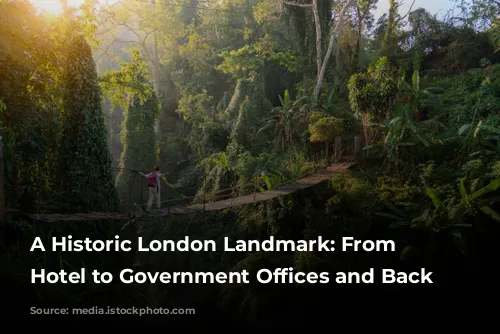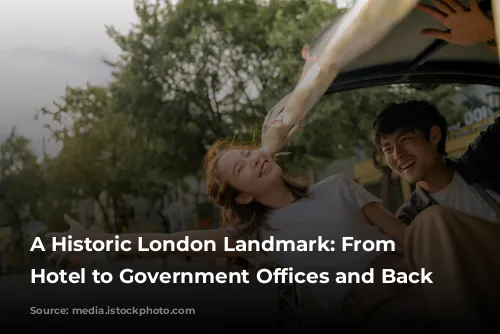The Corinthia Hotel London, a grand edifice standing proudly at the intersection of Northumberland Avenue and Whitehall Place, boasts a fascinating history that weaves through the fabric of London’s past. Nestled amidst the iconic landmarks of Trafalgar Square and the Thames Embankment, this building has witnessed pivotal moments in British history, serving as a prestigious hotel, a vital government hub, and ultimately returning to its original grandeur.
A Gilded Age Gem
In 1885, the Metropole Hotel opened its doors, a shining symbol of the Victorian era’s opulent tastes. The hotel’s prime location near the Palace of Westminster and the heart of Whitehall, the seat of British government, ensured its popularity among the elite. Its 88-page brochure, brimming with lavish descriptions, promised guests an unforgettable experience. The Metropole became a favored venue for prestigious events, hosting the annual dinners of the Aero Club and the Alpine Club, and serving as the starting point for the inaugural London to Brighton motor race in 1896.
The Prince of Wales, later King Edward VII, was a frequent guest, enjoying the comfort of his reserved box in the ballroom and the opulence of the Royal Suite, thought to be the first floor rooms overlooking Whitehall Place.
A Wartime Refuge and Government Hub
The outbreak of World War I transformed the Metropole into a vital resource for the government, as it was requisitioned to house government staff. The hotel, along with other buildings in Northumberland Avenue, became a symbol of wartime necessity. The night before the British Expeditionary Force embarked for France in 1914, the two Commanders-in-Chief, Field Marshals John French and Douglas Haig, stayed at the Metropole, underscoring its crucial role in the conflict.
After the war, the Metropole reopened its doors to the public, becoming a popular destination for entertainment, particularly for the renowned “Midnight Follies” cabaret. A young Bert Firman, at the tender age of sixteen, became the bandleader of the Midnight Follies Orchestra, a testament to his extraordinary talent.

A Witness to History and a Home for Intelligence
During World War II, the government once again requisitioned the Metropole, transforming it into a vital government building. The hotel housed various departments, with Room 424 becoming the first home for MI9, the secret intelligence agency tasked with espionage and sabotage, and its sub-division, the Special Operations Executive. The building also served as a planning center for Operation Overlord, the Allied invasion of Normandy.
Following the war, the building was purchased by the Ministry of Defence and used as an overflow building to their main Whitehall complex. The Metropole became a symbol of wartime resilience and a testament to the dedication of those who worked tirelessly behind the scenes to secure victory.

A Modern Renaissance
The Metropole Building stood unoccupied for several years after the Ministry of Defence vacated the premises in 2004. In 2007, a consortium, including Libyan and Dubai investors, acquired the building, marking a new chapter in its history. The building was transformed into a luxurious hotel and residential complex, rebranded as the Corinthia Hotel. The hotel, with its modern amenities and breathtaking views, attracted both tourists and dignitaries, continuing its legacy as a place of prestige and elegance.
The Corinthia Hotel, with its rich history, stands as a symbol of London’s enduring spirit, a testament to the city’s ability to adapt and thrive through the ages. It is a place where history, grandeur, and modern luxury intersect, offering visitors a glimpse into the city’s captivating past and a luxurious haven for the present.










